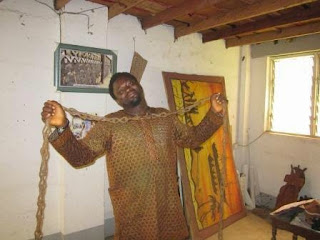I left Badagry around 9.12 A.M on Monday 13th of April, 2015, on an adventure to the villages and towns in between Dahomey and Abeokuta. I was in search of antiques that passed through this territory during the Trans Atlantic Slave trade, and during and after the Egba - Dahomey wars.
 |
| I began my trip by shopping for non perishable edible food for the adventure to the hinterland |
I began my trip by shopping for non perishable edible food stuffs like plantain chips, potato chips, skimmed milk, chocolates, ground nuts, cashew nuts and batteries for the camera for my adventures to the hinterland.
About three decisive wars were fought and the Egbas (Abeokuta) defeated the Dahomeans (Abomey) during these battles that were not won easily. The economy of the Dahomeans was based on Slave trading but the sustainability of this trade was threatened by the Europeans, both French and English. These European forces want a stop to the trade. So the Dahomean king decided to take over Abeokuta which was the strongest town around the land it wish to usurp and Abeokuta opposed it's conquering other kingdoms that were loyal to it. The king of Dahomey believes that once Abeokuta was conquered, it would be easy to run down other towns around the territory. The aim of Dahomey was to switch trade from Slave trading to Agriculture.
Many of the Yoruba villages and towns that were closer to Dahomey were destroyed by the Dahomeans and the people were captured, enslaved in Abomey and others were sold through the Slave port of Whydah (Ouidah) and Porto Novo in the modern country called Benin Republic.
The French government desired an end to Slave trading, but this will affect the economy of Dahomey, so Dahomey decided to conquer all the fertile land around it's territory. The only obstacle to this vision was Abeokuta. The dream of Dahomey for these lands was to plant Palm trees and other important farm produce that were demanded for by the European Merchants.
Abeokuta was never conquered and Slave trading continued. The Egbas (Abeokuta) also sold Slaves through the Slave port of Port Novo and Badagry. European items were exchanged for Slaves. Wealthy African Chiefs drank European gin, owned Slave instruments and chains and also owned Phonograms.
At a time in Africa, some of these items were used as a yard stick to know the Slave traders and arrest them and because of this, some of these items were buried underground. This was what motivated my adventure to these towns and villages. The trip was wonderful and successful because what seemed to be an hypothesis was actually a reality. I achieved my objectives.
Below are some of the pictures i took during the research tour and some of the Antiques i collected.
 |
| A Phonogram and an European bottle of gin |
 |
| Ankle Shackle used on Slaves |
 |
| Anago James Akeem Osho demonstrating with the Slave Chain he collected |
 |
| Anago James Akeem Osho with the ankle shackle |































